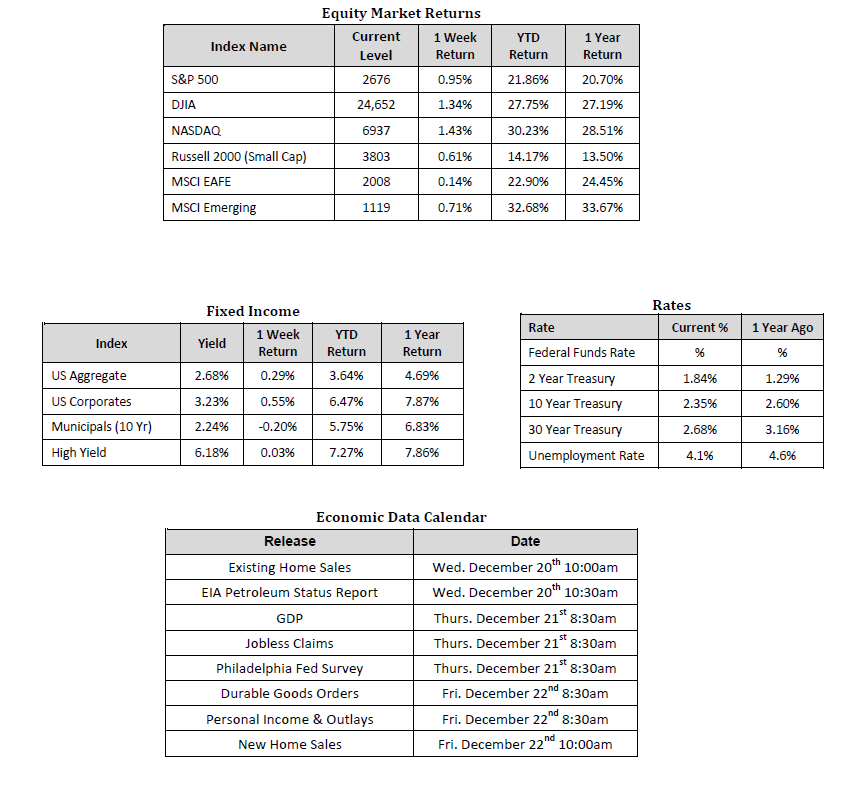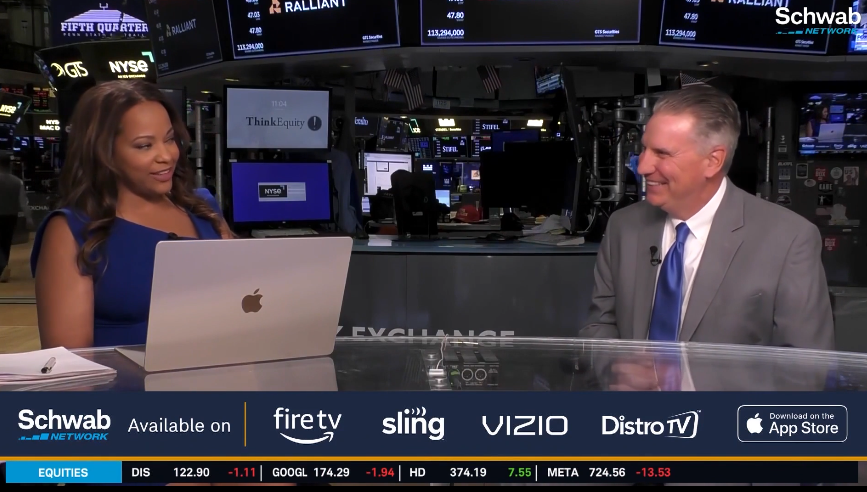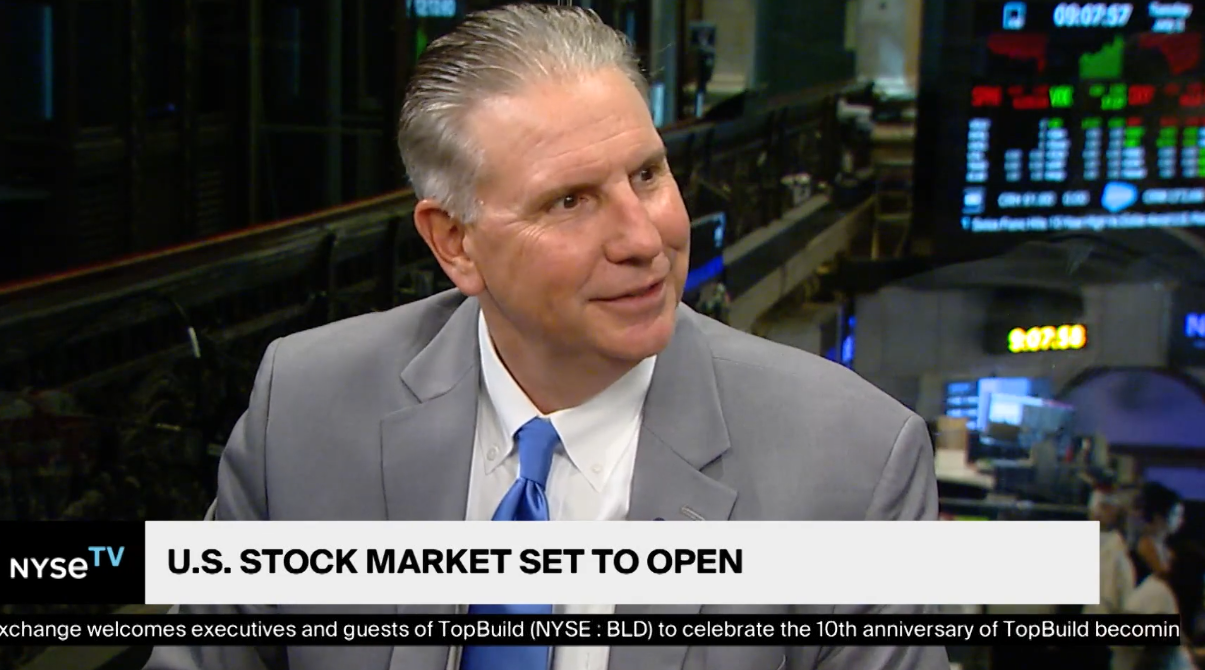
Stocks Gain as Taxes and the Fed Dominate Headlines
Market Overview
Sources: Sources for data in tables: Equity Market and Fixed Income returns are from JP Morgan as of 12/15/17. Rates and Economic Calendar Data from Bloomberg as of 12/18/17. International developed markets measured by the MSCI EAFE Index, emerging markets measured by the MSCI EM Index. Sector performance is measured using GICS methodology.
Happening Now
U.S. Stocks mostly gained last week with the S&P 500 Index rising 0.95%, the Russell Midcap Index finishing unchanged, and the Russell 2000 Index gaining 0.6%. On the international front, developed markets moved 0.14% higher while emerging markets claimed a 0.7% rise.
Markets were consumed last week yet again with Tax Reform and the Federal Reserve. On the Tax Reform front, congressional republicans were able to reconcile the House and Senate bills into one piece of legislation that will be brought before both houses of congress this week. The revised bill will lower corporate taxes to 21%, reduce the top individual bracket for the highest earners from 39.6% to 37%, and place a $10,000 cap on deductions for state and local property or income tax payments. While the jury is out on any long term economic impact of the legislation, lower corporate taxes should boost earnings and serve as a tail wind for the equity markets into the New Year.
The Federal Reserve’s Open Market Committee met last week and in a highly anticipated move, hiked the Fed Funds rate from 1.00% to 1.25%. While the interest rate increase was expected, the updates to the FOMC’s projections were a bit more curious. The Fed increased their forecast for 2018 U.S. GDP from 2.1% to 2.5%, lowered their projection for the unemployment rate from 4.1% to 3.9%, and left inflation unchanged. While substantial updates were made to their economic forecasts, the FOMC continues to project only three additional rate hikes in 2018, the same projection made in September. With the expectations for growth picking up and the unemployment rate coming down, why not suggest further tightening? According to some economists, the answer lies in the path inflation actually takes. Historically, a lower unemployment rate has meant higher inflation, however this relationship simply has not held during this recovery. So, the Fed appears willing to let the economy run hot as long as inflation stays low.
The economic recovery the U.S. has been in since 2009 has no historical precedent. The Fed’s latest updates to their forecasts only further this sentiment. We believe the U.S. economy will continue to grow in 2018 and perhaps beyond but caution investors from treating this environment like past expansions. In order to be successful investing over the next several years, one must adopt a forward looking strategy and refrain from placing too much emphasis on past performance.
Important Information and Disclaimers
Disclosures: Hennion & Walsh is the sponsor of SmartTrust® Unit Investment Trusts (UITs). For more information on SmartTrust® UITs, please visit www.smarttrustuit.com. The overview above is for informational purposes and is not an offer to sell or a solicitation of an offer to buy any SmartTrust® UITs. Investors should consider the Trust’s investment objective, risks, charges and expenses carefully before investing. The prospectus contains this and other information relevant to an investment in the Trust and investors should read the prospectus carefully before they invest.
Investing in foreign securities presents certain risks not associated with domestic investments, such as currency fluctuation, political and economic instability, and different accounting standards. This may result in greater share price volatility. These risks are heightened in emerging markets.
There are special risks associated with an investment in real estate, including credit risk, interest rate fluctuations and the impact of varied economic conditions. Distributions from REIT investments are taxed at the owner’s tax bracket.
The prices of small company and mid cap stocks are generally more volatile than large company stocks. They often involve higher risks because smaller companies may lack the management expertise, financial resources, product diversification and competitive strengths to endure adverse economic conditions.
Investing in commodities is not suitable for all investors. Exposure to the commodities markets may subject an investment to greater share price volatility than an investment in traditional equity or debt securities. Investments in commodities may be affected by changes in overall market movements, commodity index volatility, changes in interest rates or factors affecting a particular industry or commodity.
Products that invest in commodities may employ more complex strategies which may expose investors to additional risks.
Investing in fixed income securities involves certain risks such as market risk if sold prior to maturity and credit risk especially if investing in high yield bonds, which have lower ratings and are subject to greater volatility. All fixed income investments may be worth less than original cost upon redemption or maturity. Bond Prices fluctuate inversely to changes in interest rates. Therefore, a general rise in interest rates can result in the decline of the value of your investment.
Definitions
MSCI- EAFE: The Morgan Stanley Capital International Europe, Australasia and Far East Index, a free float-adjusted market capitalization index that is designed to measure developed-market equity performance, excluding the United States and Canada.
MSCI-Emerging Markets: The Morgan Stanley Capital International Emerging Market Index, is a free float-adjusted market capitalization index that is designed to measure the performance of global emerging markets of about 25 emerging economies.
Russell 3000: The Russell 3000 measures the performance of the 3000 largest US companies based on total market capitalization and represents about 98% of the investible US Equity market.
ML BOFA US Corp Mstr [Merill Lynch US Corporate Master]: The Merrill Lynch Corporate Master Market Index is a statistical composite tracking the performance of the entire US corporate bond market over time.
ML Muni Master [Merill Lynch US Corporate Master]: The Merrill Lynch Municipal Bond Master Index is a broad measure of the municipal fixed income market.
Investors cannot directly purchase any index.
LIBOR, London Interbank Offered Rate, is the rate of interest at which banks offer to lend money to one another in the wholesale money markets in London.
The Dow Jones Industrial Average is an unweighted index of 30 “blue-chip” industrial U.S. stocks.
The S&P Midcap 400 Index is a capitalization-weighted index measuring the performance of the mid-range sector of the U.S. stock market, and represents approximately 7% of the total market value of U.S. equities. Companies in the Index fall between S&P 500 Index and the S&P SmallCap 600 Index in size: between $1-4 billion.
DJ Equity REIT Index represents all publicly traded real estate investment trusts in the Dow Jones U.S. stock universe classified as Equity REITs according to the S&P Dow Jones Indices REIT Industry Classification Hierarchy. These companies are REITSs that primarily own and operate income-producing real estate.




